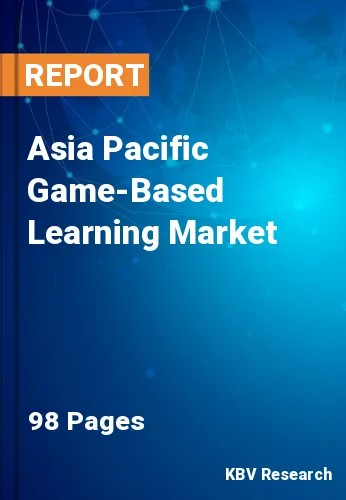The Asia Pacific Game-Based Learning Market would witness market growth of 21.5% CAGR during the forecast period (2021-2027).
Learning games also provide a safe atmosphere for students to fail. In a public setting such as a classroom, it can be difficult for students, particularly adolescents, to fail. Games provide children the opportunity to try new things. If players fail in the game's scenario, they can simply try again and learn from their mistakes. Students learn through exploration and trial and error rather than by rote memorization.
In recent years, there has been a spike in the use of virtual reality for game-based learning. Game-based virtual reality learning, as an emerging unique and advanced platform has the potential and ability to solve a variety of complex educational difficulties. Virtual game-based and augmented reality learning courses have been offered by a variety of academics and institutions to their students.
Mobile devices have a high penetration rate, making them a viable platform for reaching out to hard-to-reach communities. The telecom sector is already collaborating with governments in some South Asian countries to make affordable 3G/4G-enabled cellphones with educational apps available. Rural areas are also seeing an increase in mobile data usage. Mobile device accessibility and ubiquity might be considered a crucial factor in the implementation of game-based learning solutions in the APAC region.
Integrating Technology in Education in India, which began its work in a rural section of India's eastern region, is an example of the large-scale integration of technology in teaching and learning. Tata Trusts, a philanthropic organization, is pioneering the collaboration with other NGOs who share the same goal of bridging the digital gap and enhancing deep learning experiences among upper primary and secondary school children and adolescents using technology. The use of digital games as instructional tools is not now a priority.
The China market dominated the Asia Pacific Game-Based Learning Market by Country in 2020, and would continue to be a dominant market till 2027; thereby, achieving a market value of $2,893.5 million by 2027. The Japan market is anticipated to grow at a CAGR of 20.7% during (2021 - 2027). Additionally, The India market would experience a CAGR of 22.2% during (2021 - 2027).
Based on Component, the market is segmented into Solution and Services. Based on End User, the market is segmented into Education, Consumer, Healthcare, Retail & eCommerce, Government & Defense, Manufacturing, IT & Telecom, and Others. Based on Deployment Type, the market is segmented into Cloud and On-Premise. Based on Game Type, the market is segmented into Training, knowledge & skill-based Games, Assessment & Evaluation Games, AI-based Games, AR VR Games, Language Learning Games and Others. Based on countries, the market is segmented into China, Japan, India, South Korea, Singapore, Malaysia, and Rest of Asia Pacific.
Free Valuable Insights: The Worldwide Game-Based Learning Market is Projected to reach USD 32.6 Billion by 2027, at a CAGR of 19.6%
The market research report covers the analysis of key stake holders of the market. Key companies profiled in the report include Kahoot! AS, Spin Master Corp., Breakaway Games, Raptivity (Harbinger Group), StratBeans Consulting Pvt. Ltd., Schell Games, BYJU'S (Tangible Play, Inc.), Frontier Developments plc, Bublar Group AB (Vobling AB), and Recurrence, Inc.
By Component
By End User
By Deployment Type
By Game Type
By Country
Our team of dedicated experts can provide you with attractive expansion opportunities for your business.

